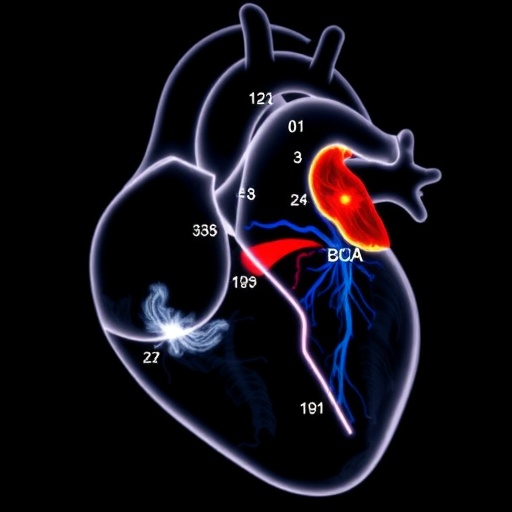In a groundbreaking advancement for cardiovascular medicine, the Society for Cardiovascular Angiography & Interventions (SCAI) has unveiled a detailed and authoritative position statement on the use of intracardiac echocardiography (ICE) to guide interventions in structural heart disease (SHD). This comprehensive roadmap marks a pivotal shift from conventional imaging modalities, notably transesophageal echocardiography (TEE), towards the integration of ICE as a frontline technology. By enabling clinicians to obtain real-time, high-resolution images directly from within the heart, ICE is poised to transform procedural precision and patient outcomes in ways previously unattainable without the risks posed by general anesthesia.
Published in the Journal of the Society for Cardiovascular Angiography & Interventions, the position statement meticulously examines the evolving role of ICE across a spectrum of SHD interventions, including mitral, tricuspid, and pulmonary valve procedures, alongside left atrial appendage closure (LAAC) and defect closures such as atrial septal defect (ASD) and patent foramen ovale (PFO). The authors highlight the comprehensive advantages brought by ICE, ranging from enhanced spatial resolution to improved procedural workflow and patient safety, effectively challenging the entrenched reliance on TEE.
Unlike TEE, which necessitates general anesthesia and intubation due to the transesophageal probe’s positioning, ICE obviates the need for such invasive sedation. This is achieved by employing catheters equipped with miniature ultrasound transducers capable of delivering intracardiac images from within the cardiovascular system itself. The enhanced visualization not only maintains but heightens the accuracy of intra-procedural imaging while concomitantly reducing the anesthesia-associated risks and recovery times.
Leading interventional cardiologist Dr. Mackram F. Eleid, Chair of the writing committee and a Mayo Clinic expert, emphasizes the transformative potential of ICE technology. He articulates that ICE is no longer confined to niche diagnostic applications but has matured into a standard-bearer for guiding complex structural interventions with unparalleled image clarity. Dr. Eleid underscores how ICE-facilitated procedures have significantly minimized complications, shortened hospital stays, and enabled same-day discharges, thus reshaping patient care paradigms.
Central to the statement is the establishment of robust, standardized ICE imaging protocols and views specifically tailored to various SHD interventions. This structured imaging framework equips operators with a reproducible methodology that enhances procedural consistency and safety across diverse clinical settings. The document further advocates for rigorous physician training pathways to develop proficiency in ICE image acquisition and interpretation, recognizing that optimal utilization requires not only technological adoption but also comprehensive clinical education.
Additionally, the statement spotlights the necessity for systemic workflow adaptations within catheterization laboratories to accommodate ICE-guided interventions effectively. This includes reevaluating institutional readiness, restructuring team roles, and optimizing scheduling to leverage ICE’s less invasive nature. According to Co-Chair Omar K. Khalique, MD, FSCAI, advancing ICE use can significantly expand treatment accessibility to patients traditionally deemed high-risk due to frailty or complex comorbidities, fundamentally altering the risk-benefit calculus for SHD procedures.
However, despite ICE’s promising clinical advantages, the position statement candidly addresses ongoing barriers hindering widespread adoption. Foremost among these are reimbursement challenges, as existing coding frameworks have not evolved to recognize the added complexity and specialist input integral to ICE-guided procedures. The committee advocates for policy reforms to align financial incentives with clinical realities, ensuring that hospitals and physicians receive adequate support to integrate ICE technology sustainably and equitably.
Moreover, while ICE has demonstrated compelling benefits, the need for further comparative research remains critical. The position statement calls for high-quality, prospective studies contrasting ICE with traditional TEE, particularly in mitral and tricuspid valve interventions, where evidence is progressively emerging but not yet definitive. Such investigations will be crucial to solidify clinical guidelines, validate outcomes improvements, and inform device development, reinforcing the integration of ICE into routine clinical practice.
From a technical perspective, ICE imaging utilizes advanced phased-array transducers that provide multiplanar imaging capabilities, enabling visualization of cardiac structures and devices during interventions with unprecedented clarity. As the technology evolves, emerging enhancements in catheter design, software integration, and image processing algorithms are anticipated to augment the diagnostic fidelity and user ergonomics further, reinforcing ICE’s role in next-generation interventional cardiology suites.
Institutional and interdisciplinary collaboration also emerges as a focal point within the roadmap. Effective implementation demands cohesive coordination among interventional cardiologists, imaging specialists, anesthesiologists, and catheterization lab staff to maximize procedural efficiency and patient safety. The reduced dependency on anesthesia resources potentially eases systemic burdens, aligning with broader hospital objectives for resource optimization and enhanced throughput.
In summary, SCAI’s position statement on intracardiac echocardiography heralds a new era in structural heart disease management. ICE is not merely an alternative imaging modality but a catalyst for reimagining procedural workflows, expanding patient eligibility, and elevating safety standards. This landmark consensus embodies a call to action for the cardiovascular community to embrace ICE’s transformative potential through concerted training, research, and policy advocacy, ultimately shaping the future landscape of minimally invasive cardiac interventions.
Subject of Research: People
Article Title: SCAI Position Statement on Intracardiac Echocardiography to Guide Structural Heart Disease Interventions
News Publication Date: 7-Oct-2025
Web References: https://www.jscai.org/article/S2772-9303(25)01392-4/fulltext
References: 10.1016/j.jscai.2025.103946
Keywords: Cardiology, Structural Heart Disease, Intracardiac Echocardiography, Transesophageal Echocardiography, Mitral Valve Intervention, Tricuspid Valve Intervention, Left Atrial Appendage Closure, Atrial Septal Defect, Patent Foramen Ovale, Cardiovascular Imaging, Transcatheter Procedures, Interventional Cardiology




